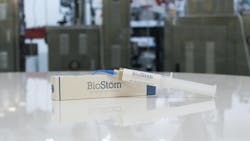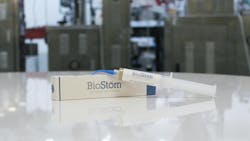Dry socket prevention with an oral hydrogel wound dressing
Dry socket, also known as alveolar osteitis, is a painful condition that can occur after a tooth extraction when the blood clot fails to form in the socket or is lost.1 This exposes the bone and nerves, which can cause pain and delay healing. Dry sockets can typically last seven to 10 days. Dry socket lesions occur in approximately 1%–5% of all extractions and in up to 38% of mandibular third molar extractions.2
What are the symptoms of dry socket?3
- Severe, persistent, throbbing pain within one to five days of the extraction
- Pain that may extend to the ear or eye on the same side of the face
- Bad breath
- A slight fever
- An unpleasant taste in the mouth
What are the risk factors for dry socket?4
- Complicated tooth extractions
- Smoking
- Use of oral contraceptives and/or high estrogen levels
- Poor oral hygiene
- Smoking or vaping
- Tooth or gum infection
- Previous dry sockets
What are the treatments for dry socket?
- Debridement of socket and placement of platelet-rich fibrin (PRF)5
- Pain relievers, such as ibuprofen or Tylenol
- Flushing the socket with a medicated mouthwash or saline
- Filling the socket with a medicated dressing
- Placing an oral hydrogel wound barrier into and over the socket
What is the BioStom oral hydrogel wound dressing?
BioStom is an oral hydrogel consisting of a proprietary formula made of all-natural, food-grade ingredients including acemannan, xylitol, eugenol, thymol, and cinnamon.
How does BioStom hydrogel lower the occurrence of dry socket?
The hydrogel adheres to the open wound and helps protect the fibrin clot in the extraction site from further irritation and contamination. Its pH is compatible with saliva so that it is soothing to oral tissues, especially since it contains essential oils. In addition, the gel matrix prevents the initiation of a pain signal without altering normal physiology. It does so by working outside nerve cells where it prevents sodium ion entry into the nerve cells initiating a pain signal. It is not absorbed into tissues or the bloodstream, and it does not numb tissues as do benzocaine, lidocaine, and other topical anesthetics.
How is the hydrogel used?
The hydrogel is dispensed in a syringe (figure 1) as it is placed over the extraction socket and dispensed to completely cover the wound. After eating or drinking, the gel should and can be replaced several times throughout the day by the patient. This gel does not interact with any prescribed or over-the-counter medications.
Editor’s note: This article originally appeared in Perio-Implant Advisory, a chairside resource for dentists and hygienists that focuses on periodontal- and implant-related issues. Read more articles and subscribe to the newsletter.
References
- Mamoun J. Dry socket etiology, diagnosis, and clinical treatment techniques. J Korean Assoc Oral Maxillofac Surg. 2018;44(2):52-58. doi:10.5125/jkaoms.2018.44.2.52
- Blum IR. Contemporary views on dry socket (alveolar osteitis): a clinical appraisal of standardization, aetiopathogenesis and management: a critical review. Int J Oral Maxillofac Surg.2002;31(3):309-317. doi:10.1054/ijom.2002.0263
- Bowe DC. The management of dry socket/alveolar osteitis. J Ir Dent Assoc. 2011;57(6):305-310.
- Younis MHA, Hantash ROA. Dry socket: frequency, clinical picture, and risk factors in a palestinian dental teaching center. Open Dent J.2011;5:7-12. doi:10.2174/1874210601105010007
- Laforgia A, Inchingolo AD, Riccaldo L, et al. The use of platelet-rich fibrin (PRF) in the management of dry socket: a systematic review. Int J Mol Sci. 2024;25(18):10069. doi:10.3390/ijms251810069
About the Author

Scott Froum, DDS
Editorial Director
Scott Froum, DDS, a graduate of the State University of New York, Stony Brook School of Dental Medicine, is a periodontist in private practice at 1110 2nd Avenue, Suite 305, New York City, New York. He is the editorial director of Perio-Implant Advisory and serves on the editorial advisory board of Dental Economics. Dr. Froum, a diplomate of both the American Academy of Periodontology and the American Academy of Osseointegration, is a volunteer professor in the postgraduate periodontal program at SUNY Stony Brook School of Dental Medicine. He is a PhD candidate in the field of functional and integrative nutrition. Contact him through his website at drscottfroum.com or (212) 751-8530.

